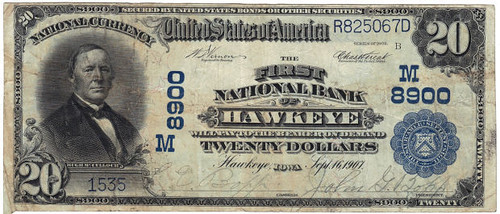
PREV ARTICLE
NEXT ARTICLE
FULL ISSUE
PREV FULL ISSUE
ARTICLE HIGHLIGHTS NATIONAL BANK NOTE HISTORYLocal newspapers often publish a fractured version of numismatic facts, so it's refreshing to read an article that gets it
right. The Waterloo Cedar Falls Courier of Waterloo, Iowa published a nice article this week featuring a local National Bank Note. The article
includes a well-written short history of the National Bank system and some hobby history that I wasn't aware of. Here's an excerpt.
-Editor
 Retrieve some folding money from a bank in Iowa these days and the bills, except for a few numbers, will look exactly like those picked up in another state or on far sides of the United States. That wasn't always the case. In fact, from 1863 to 1935 -- a period of more than 70 years -- bills from different communities and even competing banks bore a striking difference. Each could carry the name of its city in prominent letters and required signatures of bank officials representing the financial institutions. According to the Federal Reserve, Congress passed the National Banking Act at the height of the Civil War. The goal was to establish a national banking system and, by extension, a uniform currency. With the National Banking Act, financial institutions even in very small towns, if they purchased U.S. government securities, could issue their own banknotes. And they did. Iowa wound up with 496 national banks in 301 towns, each issuing their own currency. Waterloo, for instance, had six national banks. Cedar Falls had three. Garrett's auction Feb. 28 will include banknotes issued in Iowa, including a rare beauty from the First National Bank of Hawkeye in 1907. The Peoples National Bank of Independence and First National Bank of Independence are also represented. Logically, a bank in a large city would issue more currency. The Levitt & Johnson National Bank of Waterloo was the leader in the metro area, distributing slightly more than $3 million from 1898 to 1932. "The banknotes were printed in Washington, D.C., and mailed to the banks, where they were signed by the cashier and president of each bank," according to Garrett. "Because it was commonplace and just a part of everyday life, very few people thought to save these banknotes. Today many of them are extremely rare and worth thousands of dollars to the collectors who specialize in them," he adds. The First National Bank of Hawkeye had $319,570 printed from 1907 to 1933. The Hawkeye cash came in nine types and denominations. But again, the remaining stock is very small. Of the vintage Hawkeye money, the survivors are two $20 bills, four $10 bills and eight $5 bills, according to Garrett. "Iowa is kind of the national birthplace of banknote collecting," he says. Two men in particular set the standards that govern the trade. John Hickman and Dean Oakes were based in Iowa City and made sales from 1976 to 1989. According to some sources, even their catalogs are now deemed collectible. Hickman found a friend in fellow collector William Higgins Jr., described as a man with means. Hickman helped Higgins assemble a collection, which in 1978 became the Higgins Museum of National Banknotes in Okoboji. The collection today features bills from 278 Iowa towns representing each of the state's 99 counties. Higgins was a contemporary and friend of Ronald Reagan. So besides banknotes, the museum's collection includes an antique "spider" currency printing press, a display arranged for Higgins by President Reagan. I've known about the Higgins Museum for years and have always wanted to go sometime, but until Disney builds a theme park in
Okoboji my wife will have none of it. I was unaware of the connection with Ronald Reagan. -Editor
To read the complete article, see: For more information about the Higgins Museum, see: Wayne Homren, Editor The Numismatic Bibliomania Society is a non-profit organization promoting numismatic literature. See our web site at coinbooks.org. To submit items for publication in The E-Sylum, write to the Editor at this address: whomren@gmail.com To subscribe go to: https://my.binhost.com/lists/listinfo/esylum All Rights Reserved. NBS Home Page Contact the NBS webmaster 
|